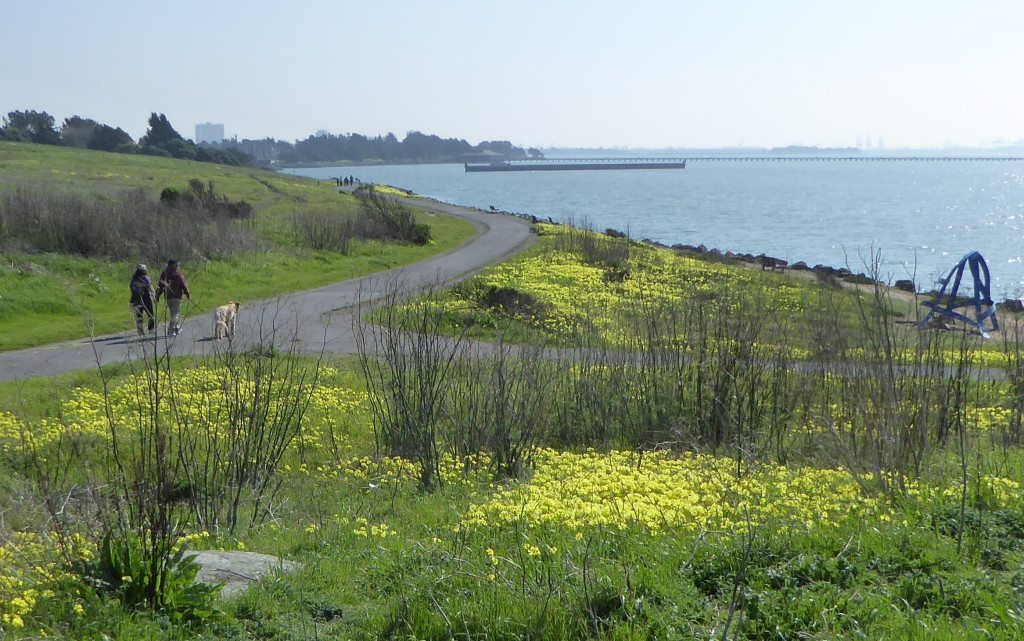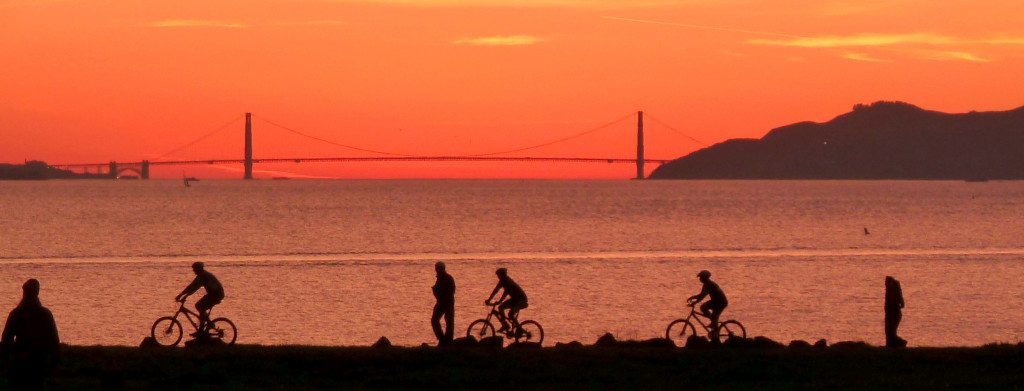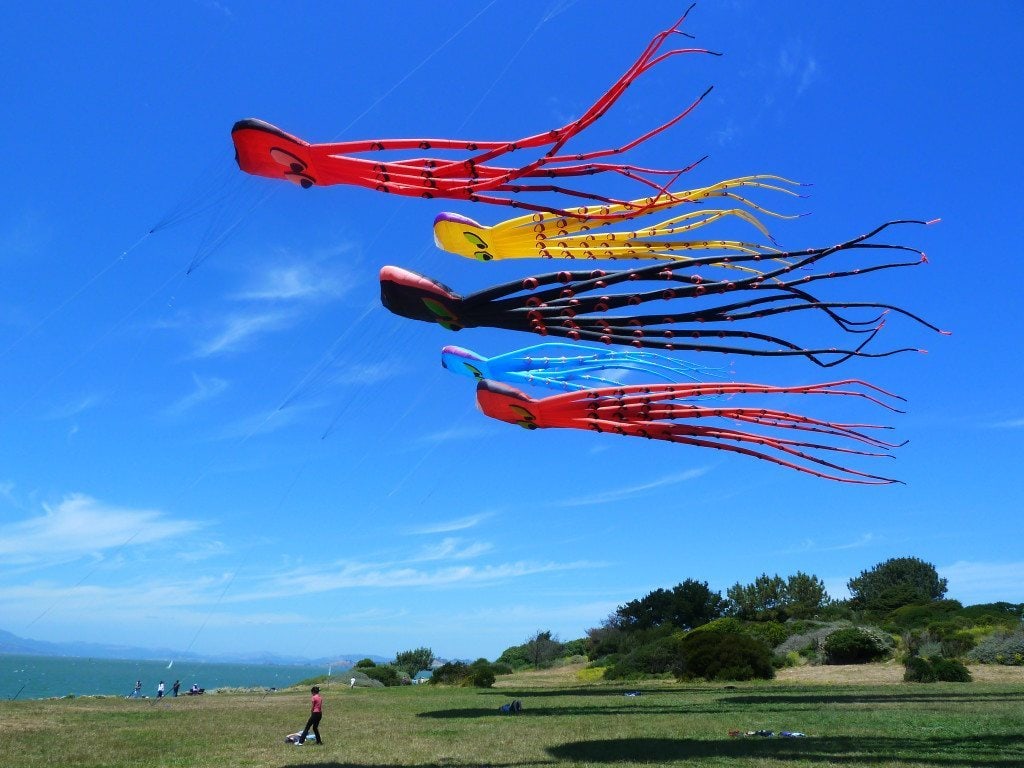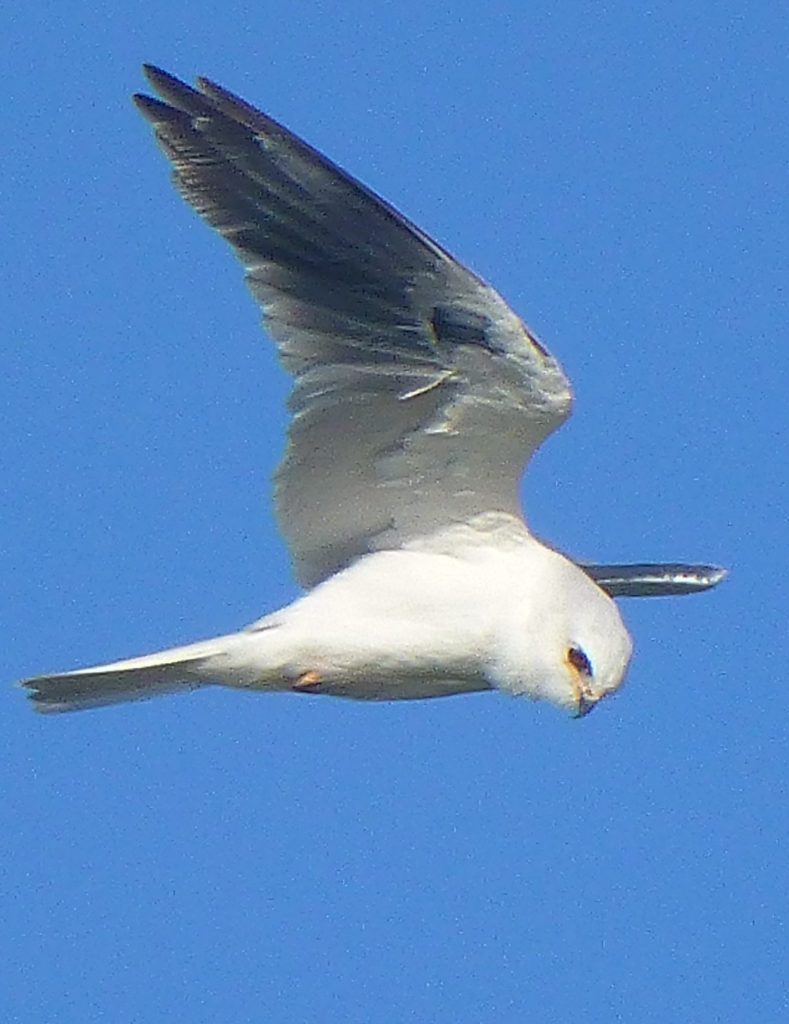Cesar Chavez Park: Birding Hotspot
By Toni Mester
Berkeley old-timers remember when Cesar Chavez Park was a dump, the last of the active East Bay landfills. It would cost nothing to leave a truckload of trash on a smelly mound, surrounded by thousands of circling gulls. After the dump closed in 1983, the 90 acres on San Francisco Bay were capped and sealed and gradually transformed into a park with some of the most astounding views in the Bay Area.
The Park is also a treasure trove for birders, who can spot both land and water birds (over 150 species, according to eBird) from low hills and grass lands surrounded by the Bay to the north and west and the shallow tidal North Basin to the east. Golden Gate Bird Alliance hosts a docent program at the Burrowing Owl habitat, where if you’re lucky you can spot one of these rarely-seen birds during their winter sojourn.
Entering the park near the DoubleTree Hotel (where the road turns), you’ll find the North Basin on your right with a view of I-80 and the East Bay hills. During the winter, the most common water birds feeding here are scaups, buffleheads, ruddy ducks, grebes, coots, and egrets. Some of the ducks stay on during the summer, but most return to their northern homes at the end of March or early April. The usually calm waters serve as a migratory massing site, where thousands collect before taking off, bobbing about in rough chevron formation. In my years of walking the perimeter trail, I have only seen this astounding sight once.

Just inland, the industrial stack of a methane flare station collects and burns the off-gassing from the landfill, which is still actively decomposing. Because the volume of gas has decreased, the old inefficient apparatus will be decommissioned this year and replaced with a more compact facility with a smaller stack, next to the current location.
About midway on the path, look for a bird ID plaque, showing photos of the most common birds. Further along at the northeast corner, the Burrowing Owl habitat usually attracts observers when the birds can be seen poking their heads out of a ground squirrel burrow, between November and March. These small owls – a California Species of Concern — are almost invisible because of their coloring, but a docent with a spotting scope can show you where to look.
Note the low concrete art installation on the north side of the path. GGBA volunteers worked with the city to create a sculpture that echoes the line of the hills and provides a barrier to protect the owls when they’re present.


The ground squirrels that provide the owls’ winter homes became the center of controversy in 2014, after the Regional Water Quality Board put the City of Berkeley on notice that their burrows could potentially penetrate the landfill’s clay cap and allow toxic leachate into the Bay. The City responded by suggesting a test program to catch and abate the rodent population, which led to a worldwide outcry against killing the squirrels.
The Public Works Department then switched gears and formed a committee — led by Golden Gate Bird Alliance’s Carla Din and other wildlife advocates — to control the squirrel population more humanely by prevention of feeding. New stiff fines have been imposed for feeding the squirrels, and fresh signs explain to visitors why feeding is harmful to wildlife. The Water Board is taking a wait-and-see position.


As you turn the corner going west, you leave behind the visible signs of civilization with just the Bay and Mount Tamalpais in the distance. You could be in the Outer Hebrides. I call this stretch “Loch Berkeley” and like to pretend that I’ve taken the low road to Scotland. Look for the Barn Owl boxes, high on stilts. The Barn Owl is the official bird of Berkeley, although hard to spot at the waterfront, where they hunt gophers in the early spring. Another gopher hunter is a Great Blue Heron, fondly named Oscar by the locals, who lunches on the rodents in the meadows at the south end of the park.
The trail is lined with sweet fennel, where you can spot Red-winged Blackbirds, one of the most populous of the common land birds, along with sparrows, finches, crows, robins, and with luck, a meadowlark.
Along the western edge, the bay-loving gulls dominate, but you can also spot the occasional Brown Pelican. You’ll likely see some of the cormorants that nest in the abandoned skeleton of the old Bay Bridge, much to the consternation of CalTrans, which has been spending upwards of half a million dollars trying to lure them into spiffed up “cormorant condos” on the new span. Nothing doing! They love their old digs, as well as their hunting ground along the rip-rap at Chavez Park.
The southwest corner of the perimeter trail brings you to a ridge of native vegetation, designed and planted by DAWN (Design Associates Working with Nature) in 1984, the last time that any mass planting was attempted at the Park. Years of neglect since then are visible in the many worn and bare areas created by people cutting paths through the grassland. Maintenance of the grassy area is finally being addressed by the City, thanks to pressure from dog walkers whose pets are endangered by foxtail grasses growing in the 17-acre off-leash area.


The dog walkers demanded more mowing, and the City responded by hiring Jim Martin of Environmental Collaborative to complete a Biological Resource Assessment with alternatives such as more mowing, better vegetation management, or moving the off-leash area to the southeast meadow, which can be mowed more easily.
GGBA’s East Bay Conservation Committee supports the alternative of moving the off-leash area to the southeast meadow, which would not only be more mowable but would be closer to parking and further from the Burrowing Owls and other wildlife.
The biological assessment and public comments, including those by GGBA, can be found at the City Parks, Recreation, and Waterfront web pages. (The GGBA comments are on pages 113-126 and contain a recent list of species found at the Park from eBird.)
The Berkeley Parks and Waterfront Commission will take up the matter at their March 11 meeting starting at 7 p.m. at the Frances Albrier Center in San Pablo Park.
But enough park politics, and back to our walk!
To complete the loop, follow the perimeter trail along Spinnaker Way or head inland along either of two paths that lead you through or alongside the off-leash dog area. Along the western ridge, the Cesar Chavez Memorial solar calendar, designed by Santiago Casal, is worth a visit for its cultural interest as well as spectacular views of San Francisco and the Golden Gate.
Fast Facts
Location: 11 Spinnaker Way in West Berkeley, along the Bay waterfront.
Hours/Fees: 6 a.m. to 10 p.m. unless otherwise noted. Free.
Dogs: Allowed off-leash in 17-acre off-leash area, and on-leash elsewhere.
Habitat: Shoreline, grassy fields, meadow with a lot of human disturbance.
Key Birds:
Year-Round:
Western and Clark’s Grebe, Double-crested Cormorant, Pelagic Cormorant, Brown Pelican, Great Blue Heron, Red-tailed Hawk, Killdeer, various gulls, Mourning Dove, Barn Owl, Anna’s Hummingbird, Black Phoebe, American Crow, Common Raven, European Starling, California Towhee, Brewer’s Blackbird, House Finch, Song Sparrow, Savannah Sparrow
Summer-only resident breeders:
Caspian Tern, Barn Swallow
Winter:
Canada Goose, American Wigeon, Mallard, Great and Lesser Scaup, Surf Scoter, Bufflehead, Common Goldeneye, Ruddy Duck, Common Loon, Horned and Eared Grebe, Great Egret, Snowy Egret, Turkey Vulture, White-tailed Kite, American Coot, Black Oystercatcher, Spotted Sandpiper, Greater Yellowlegs, Willet, Black Turnstone, Dunlin, Least Sandpiper, Forster’s Tern, Burrowing Owl, Chestnut-backed Chickadee, Bushtit, Ruby-crowned Kinglet, Hermit Thrush, American Robin, American Pipit, Yellow-rumped Warbler, Fox Sparrow, White-crowned Sparrow, Golden-crowned Sparrow, Western Meadowlark
Ease of Access: A fairly flat, paved trail circles the park and goes past the Burrowing Owl area. The perimeter trail is wheelchair- and stroller-accessible.
Getting There:
By car: From I-80, turn west towards the Bay on the University Avenue exit. Pass the McLaughlin Park meadow and take the first right onto Marina Blvd. The best place to leave your vehicle is opposite the DoubleTree Hotel, just before Marina Blvd. turns left and becomes Spinnaker Way. This will put you on the southeast corner of the perimeter trail, a level loop of slightly more than one mile that takes you past the Burrowing Owl habitat.
NOTE: The Berkeley Marina is notorious for car burglaries, so be sure to store all valuables out of sight or take them with you.
By transit: From the downtown Berkeley BART station, take the 51B bus down University Avenue towards the waterfront. Get off at the intersection with Marina Blvd. and walk north to the park.
Nearby services: Portable toilets on Spinnaker Way. Picnic tables.
Nearby cafes/restaurants: The Sea Breeze Market and Deli, next to I-80 at 598 University Avenue, offers fish and chips, clam chowder, fried oysters, burgers, sandwiches and drinks. The Berkeley Marina houses several more formal/expensive restaurants including Skates by the Bay.
For more information:
————————————————-
Toni Mester is a member of the GGBA East Bay Conservation Committee. She has lived in West Berkeley since 1979. Martin Nicolaus, a Berkeley resident since 1992, is a retired attorney and non-profit leader, writer, activist, and amateur photographer. He is author of From Trash to Treasure: The Splendors of Berkeley’s Cesar Chavez Park (Duplex Press, 2014).
Click here for more reviews of Birding Hotspots by Golden Gate Bird Alliance members.
